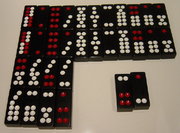Tien Gow Chinese Domino Rules
How To Play Tien Gow Dominoes

Tien Gow is the name of a Chinese trick-taking gambling game for 4 players. The game is played with a set of Chinese dominoes. Heaven is the top rank tile of the civilian suit; Nine is the top rank tile of the military suit of the domino set.
"Tien Gow" is sometimes spelled Tin Kau, and is the transliteration of two Chinese characters (tin gau) in Cantonese: Heaven and Nine. In Mandarin, it is pronounced as Tian Jiu.
In the book Chinese Origin Of Playing Cards published in 1895, Sir William Henry Wilkinson pointed out that the game of Tien Gow was invented long before the Sung Dynasty but was standardized in 1120:
[Quote from page 66. Note this publication predated the modern pinyin transliteration system]
It is perfectly clear, indeed, that all that was done or asked for in 1120 was an imperial decision as to which of several forms or interpretations of the game now known as T'ien-kiu ("Heavens and Nines") was to be considered orthodox. The game and the cards must have been in existence long before. The passage from the Cheng-tzâ-t'ung runs thus (s.v. pa'i):
Also ya p'ai now the instruments of the game. A common legend states that in the second year of the Hsüan-ho, in the Sung dynasty [i.q. 1120 AD], a certain official memorialized the throne, praying that the ya p'ai (ivory cards) be fixed as a pack of 32, comprising 127 pips [sic, it should be 227, but Chinese printers are careless], in order to accord with the expanse of the stars and constellations. The combination 'heaven' [6/6, 6/6] consisted of two pieces, containing 24 pips, figures of the 24 solar periods; 'earth' [1/1, 1/1] also composed two pieces, but contained 4 pips, the 4 points of the compass - east, west, south, and north; 'man' [4/4, 4/4] two pieces, containing 16 pips, the virtues of humanity, benevolence, propriety, and wisdom, four-fold; 'harmony' [2/3, 1/3] two pieces of 8 pips, figuring the breath of harmony, which pervades the eight divisions of the year. The other combinations had each their names. There were four players having eight cards apiece for their hand, and the cards won or lost according as the number of the pips was less or in more the winner being rewarded with counters. In-the time of Kao-tsung [1127-1163] pattern packs were issued by imperial edict. They were known throughout the empire as Ku p'ai, 'bone p'ai;' but it does not follow that this class of games, po-sai, Ko-wu, and the rest originated in the reign of Hsüan-ho.
Article text based on the Wikipedia, licensed under the GFDL.
Other Sources of Tien Gow Chinese Domino Rules
Tien Gow Chinese Domino Games
- Heaven-Nine For Windows - by Siu-Ki Wong
- Tien Gow for Palm OS - by Alan Chan

 Dominoes Info
Dominoes Info